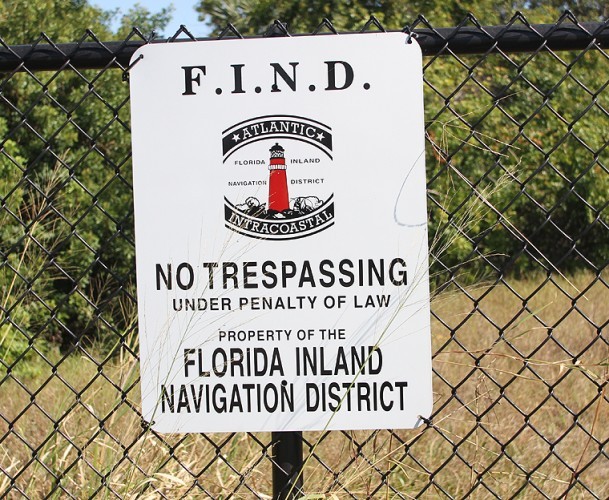
INDIAN RIVER COUNTY — The Florida Inland Navigation District plans to go ahead and dredge 140,000 cubic yards of muck in the Intra-coastal Waterway north of the Wabasso Bridge and store it in a massive containment pit surrounded by residential neighborhoods even though the material contains three times as much arsenic as a state standard suggests.
FIND says the carcinogenic metal will not endanger residents.
In a Nov. 13 letter, FIND Executive Director David Roach wrote that the Florida Department of Environmental Protection has determined containment pits like the one at Duck Point in Sebastian where the muck will be stored to dry out “are suitable to place these types of material. The arsenic bonds to the sediment and does not become soluble.”
Project opponents, including more than 600 Sebastian residents, will almost certainly dispute FIND’s assessment of risk posed by the arsenic-tainted sediment, but the agency’s claim is backed up by respected independent scientists.
“The measurements [found in recent testing] are nothing to get excited about,” says John H. Trefry, Professor of Chemical Oceanography at the Florida Institute of Technology.
Results reported last week from tests conducted in September found elevated levels of arsenic in 17 of 27 sediment samples taken from the lagoon.
The FDEP’s Soil Cleanup Target Level for arsenic in residential areas is 2.1 milligrams per kilogram. The highest level found in sediment samples taken from the area FIND plans to dredge was 6.6 mg/kg.
“That is less than seven parts per million,” says Trefry. “It is nothing to be concerned about at all.”
A 2012 report presented at the Annual International Conference on Soils, Sediments, Water and Energy supports Trefry’s view.
Studying an arsenic-contaminated wetland near a landfill in Massachusetts, report author Pamela O. Lamia found the chemical is only bioavailable and a danger to humans at a level of 150 milligrams per kilogram or higher.
FIND hired Delray Beach-based American Vibracore Services at a cost of $76,000 to take sediment samples from three shoaling sections of the Intracoastal Waterway in Indian River County.
“They took core samples by vibrating and pounding in a tube that went down 15 feet below mean low water, encompassing the full depth we will dredge,” says Roach. “A state-certified lab tested the material for grain size, organic content, pesticides, PCBs, petroleum products, and metals like mercury, arsenic, lead and zinc.”
Tests were conducted for more than 60 substances and the muck turned out to be remarkably clean. Aside from arsenic and one sample with mercury, no other metals were found at levels exceeding state guidelines.
According to a 300-page report on the test results made public by FIND no petroleum or pesticide residues were discovered.
FIND, a special taxing district created by the Florida Legislature in 1927 to create and keep open a waterway along Florida’s Atlantic coast, began planning the dredging project and storage pit in 1997.
At that time, the district did some sediment testing, which found no contamination, and held public meetings to inform residents and hear feedback about the plan.
In 2001, FIND bought a 180-acre property across from Whispering Pines mobile home community known as Vickers Grove as a containment site.
In 2007, it began the process of seeking a permit to build the dredge material storage area. No additional contamination testing was done and no meetings were held to update the public.
When the permit was granted and construction on the pit began in early 2011 it caught residents by surprise.
Many of them had moved to the area in the years since the public meetings in the 1990s and discovering what was going on in a piecemeal way stirred up fear and resentment.
Hostility to the project increased when local groups realized FIND had not tested the muck it planned to dredge for toxic substances in 14 years.
When project opponents packed a county commission meeting in June 2011, county commissioners, State Rep. Debbie Mayfield and other area politicians saw the handwriting on the wall and added their voices to the chorus calling for new tests.
In September 2011, FIND agreed to retest the muck and Roach said testing would likely be underway within 60 days.
But FIND’s first testing plan did not satisfy project opponents or area scientists, including Trefry, who said the depth and frequency of samples was not adequate to protect public safety.
“Getting the testing done was a longer, more drawn-out process than we anticipated,” Roach says. “We went back and forth with the concerned citizens and the navigation district board of commissioners and came up with three different sampling plans before we got one approved.”
While waiting for test results Roach said if the sediment was not contaminated FIND would proceed with the dredging and storage project as planned.
“We will go through engineering and design this year along with a bid process and be dredging by late 2013 or early 2014,” he said.
The storage pit built by the Army Corps of Engineers has been complete for months.



